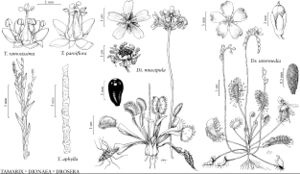Tamarix parviflora
in A. P. de Candolle and A. L. P. P. de Candolle, Prodr. 3: 97. 1828.
Common names: Small-flower tamarisk
IllustratedIntroducedWeedy
Shrubs or trees, to 5 m. Leaves: blade lanceolate, 2–2.5 mm. Inflorescences 1.5–4 cm × 3–5 mm; bract exceeding pedicel, not reaching calyx tip. Flowers 4-merous; sepals 1–1.5 mm, margins entire or denticulate; petals oblong to ovate, 2 mm; antisepalous stamens 4, filaments confluent with nectar disc lobes, all originating from edge of disc. 2n = 24.
Phenology: Flowering early spring–early summer.
Habitat: Riverways, lakeshores
Elevation: 0–1500 m
Distribution

Introduced; Ariz., Calif., Colo., Kans., Miss., Nev., N.Mex., N.C., Okla., Oreg., Tex., Utah, Wash., s Europe, n Africa, also in Mexico (Baja California), South America (Argentina), Australia
Discussion
The name Tamarix tetrandra Pallas has been misapplied to T. parviflora.
Selected References
None.
Lower Taxa
None.
... more about "Tamarix parviflora"
lanceolate +
Small-flower tamarisk +
confluent +
straight +
absent +
4-merous +
capsular +
loculicidal +
Present +
true +
sessile +
alternate +
scale-like +
fleshy +
plurilocular +
pear--shaped +
bitegmic +
anatropous +
parietal +
absent +
thin +
2 cm20 mm <br />0.02 m <br /> (?) +
(2-)3-4(-5)-carpellate +
in A. P. de Candolle and A. L. P. P. de Candolle, Prodr. +
1828 +
attached +
distinct +
equal +
beaked +
comose +
absent +
Tamarix parviflora +
Tamarix +
species +
